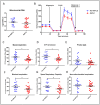Mitochondrial Dysfunction in Peripheral Blood Mononuclear Cells as Novel Diagnostic Tools for Non-Alcoholic Fatty Liver Disease: Visualizing Relationships with Known and Potential Disease Biomarkers
- PMID: 37510108
- PMCID: PMC10378438
- DOI: 10.3390/diagnostics13142363
Mitochondrial Dysfunction in Peripheral Blood Mononuclear Cells as Novel Diagnostic Tools for Non-Alcoholic Fatty Liver Disease: Visualizing Relationships with Known and Potential Disease Biomarkers
Abstract
Non-alcoholic fatty liver disease (NAFLD) is a health emergency worldwide due to its high prevalence and the lack of specific therapies. Noninvasive biomarkers supporting NAFLD diagnosis are urgently needed. Liver mitochondrial dysfunction is a central NAFLD pathomechanism that changes throughout disease progression. Blood-cell bioenergetics reflecting mitochondrial organ dysfunction is emerging for its potential applications in diagnostics. We measured real-time mitochondrial respirometry in peripheral blood mononuclear cells (PBMCs), anthropometric parameters, routine blood analytes, and circulating cytokines from a cohort of NAFLD patients (N = 19) and non-NAFLD control subjects (N = 18). PBMC basal respiration, ATP-linked respiration, maximal respiration, and spare respiratory capacity were significantly reduced in NAFLD compared to non-NAFLD cases. Correlation plots were applied to visualize relationships between known or potential NAFLD-related biomarkers, while non-parametric methods were applied to identify which biomarkers are NAFLD predictors. Basal and ATP-linked mitochondrial respiration were negatively correlated with triglycerides and fasting insulin levels and HOMA index. Maximal and spare respiratory capacity were negatively correlated with IL-6 levels. All the mitochondrial respiratory parameters were positively correlated with HDL-cholesterol level and negatively correlated with fatty liver index. We propose including blood cell respirometry in panels of NAFLD diagnostic biomarkers to monitor disease progression and the response to current and novel therapies, including mitochondrial-targeted ones.
Keywords: correlation plot; mitochondrial bioenergetics; non-alcoholic fatty liver disease; peripheral blood mononuclear cells; random forest; relative variable importance.
Conflict of interest statement
The authors declare no conflict of interest. The funders had no role in the design of the study; in the collection, analyses, or interpretation of data; in the writing of the manuscript, or in the decision to publish the results.
Figures




Similar articles
-
A Mediterranean Diet-Oriented Intervention Rescues Impaired Blood Cell Bioenergetics in Patients with Metabolic Dysfunction-Associated Steatotic Liver Disease.Diagnostics (Basel). 2024 Sep 14;14(18):2041. doi: 10.3390/diagnostics14182041. Diagnostics (Basel). 2024. PMID: 39335721 Free PMC article.
-
Mitochondrial dysfunction as a mechanistic biomarker in patients with non-alcoholic fatty liver disease (NAFLD).Mitochondrion. 2021 Mar;57:119-130. doi: 10.1016/j.mito.2020.12.010. Epub 2020 Dec 31. Mitochondrion. 2021. PMID: 33387664
-
Cardiometabolic risk factors are associated with immune cell mitochondrial respiration in humans.Am J Physiol Heart Circ Physiol. 2020 Aug 1;319(2):H481-H487. doi: 10.1152/ajpheart.00434.2020. Epub 2020 Jul 17. Am J Physiol Heart Circ Physiol. 2020. PMID: 32678706 Free PMC article.
-
Hepatocyte Mitochondrial Dynamics and Bioenergetics in Obesity-Related Non-Alcoholic Fatty Liver Disease.Curr Obes Rep. 2022 Sep;11(3):126-143. doi: 10.1007/s13679-022-00473-1. Epub 2022 May 2. Curr Obes Rep. 2022. PMID: 35501558 Free PMC article. Review.
-
From Non-Alcoholic Fatty Liver to Hepatocellular Carcinoma: A Story of (Mal)Adapted Mitochondria.Biology (Basel). 2023 Apr 14;12(4):595. doi: 10.3390/biology12040595. Biology (Basel). 2023. PMID: 37106795 Free PMC article. Review.
Cited by
-
A Mediterranean Diet-Oriented Intervention Rescues Impaired Blood Cell Bioenergetics in Patients with Metabolic Dysfunction-Associated Steatotic Liver Disease.Diagnostics (Basel). 2024 Sep 14;14(18):2041. doi: 10.3390/diagnostics14182041. Diagnostics (Basel). 2024. PMID: 39335721 Free PMC article.
-
A Defective Circulating Mitochondrial Bioenergetics Profile Reflects the Hepatic One and Outlines Genetic MASLD.Antioxidants (Basel). 2025 May 22;14(6):618. doi: 10.3390/antiox14060618. Antioxidants (Basel). 2025. PMID: 40563253 Free PMC article.
-
Mediterranean-Oriented Dietary Intervention Is Effective to Reduce Liver Steatosis in Patients with Nonalcoholic Fatty Liver Disease: Results from an Italian Clinical Trial.Int J Clin Pract. 2024 Jan 25;2024:8861126. doi: 10.1155/2024/8861126. eCollection 2024. Int J Clin Pract. 2024. PMID: 38303926 Free PMC article.
-
The Impact of Weight Loss on Inflammation, Oxidative Stress, and Mitochondrial Function in Subjects with Obesity.Antioxidants (Basel). 2024 Jul 19;13(7):870. doi: 10.3390/antiox13070870. Antioxidants (Basel). 2024. PMID: 39061938 Free PMC article.
References
-
- European Association for the Study of the Liver (EASL) European Association for the Study of Diabetes (EASD) European Association for the Study of Obesity (EASO) EASL–EASD–EASO Clinical Practice Guidelines for the Management of Non-Alcoholic Fatty Liver Disease. J. Hepatol. 2016;64:1388–1402. doi: 10.1016/j.jhep.2015.11.004. - DOI - PubMed
Grants and funding
LinkOut - more resources
Full Text Sources

